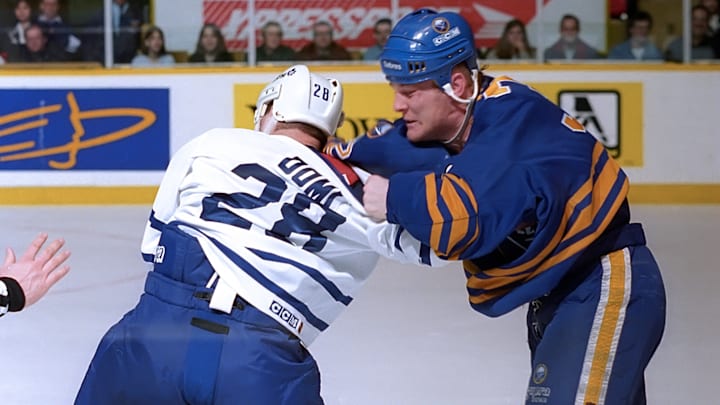If you’re reading this article, you’re either new to hockey or just curious as to why they allow fighting in hockey. And by they, I mean the NHL. After all, if you watch an NFL game and two players fight, they’re usually getting thrown out, and the same occurs when the benches clear in the MLB or when punches are thrown in the NBA.
But in hockey, two players drop gloves, everyone else, including the officials, backs off, and the two players trade punches until the referees either decide to step in, one of the players falls to the ice, or both players end up on the ice.
So, why is fighting allowed? The short answer is this: The NHL rulebook allows fighting, so as long as it’s tolerated, fighting in the game will continue.
That said, there is also a deeper answer to this question, which is that fighting allows the players more power to dictate the game. When you watch a hockey game, you’re going to see a lot of scuffles, most of which don’t end up as a fight between two players. This happens because, when you watch closely, one player may have hit an opponent following a whistle, used their stick to take a small jab at the goaltender, or following a controversial hit, like when one player boards another.
Fighting in hockey has its repercussions in more than just one way
Often, when a skirmish between all five skaters on each team develops, the officials separate them, and sometimes, you’ll see two-minute minors issued for roughing. But when two players agree to go further and actually drop gloves, this is when the officials back off and allow the fight to commence.
Once the fight ends, both players are given a five-minute major, and once they serve their penalty, they’re allowed to return to action as though nothing happened. Compare that to the NFL, MLB, or NBA, and there are times you’ll see them talking about a fight or altercation for the entire week. For the NHL and in many levels of hockey, it’s just part of the game.
However, there are times when a player could receive an additional punishment, and one way is if one player tries to force another to fight. The player attempting to instigate the fight will face more severe repercussions, as Rule 46.11 in the NHL Rulebook states, “A player who is deemed to be the instigator of an altercation shall be assessed an instigating minor penalty, a major penalty for fighting and a ten-minute misconduct.”
Yeah, so if one player wants to drop gloves, they better be sure their opponents are willing to drop them too, or else they will face some severe repercussions. Also, the two players who initially agreed to the fight are the only two allowed to fight in that given frame. Any other fights that break out, or if a third man tries to interfere in the fight, may lead to a game misconduct if the officiating crew deems it necessary.
Famous fights in Sabres history
If you’re on this site, chances are, you’re likely interested in the Buffalo Sabres and some of their history. Well, there is one rather infamous moment in team history when it comes to fighting, one that is sometimes dubbed “The Ottawa Brawl,” or the “Sabres-Senators Brawl.”
There was also the fierce rivalry between Rob Ray and Tie Domi, two enforcers who dropped gloves against one another 13 times throughout their respective careers. And the two crossed paths often, with Ray having suited up for the Sabres between 1989-90 and 2002-03, while Domi played for the rival Toronto Maple Leafs between 1995-96 and 2005-06.
Of course, Rob Ray was involved in plenty of fights throughout his career, which explains the 3,189 penalty minutes he racked up as a Sabre. Ray also led the league in penalty minutes twice during his time in Buffalo, once in 1990-91, when he finished the year with 350 minutes, and again in 1998-99 with 261 minutes.
